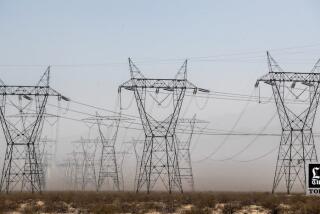Regardless, There’s Electricity in the Air
When members of the Electrochemical Society woke up on the morning after the night before, the cars of Los Angeles were still out there, cooking up photochemical smog as usual, and cold fusion was still only an item on science’s wish list.
Monday night had witnessed a gladiatorial clash between the forces of cold fusion and the faction that holds it in doubt, if not contempt. Scientist contradicted scientist, sometimes testily, over heat production, radiation levels, helium measurements.
Come Tuesday morning, the business of the society’s weeklong meeting here was back on schedule. Back to “Scanning Tunnelling Microscopy of Electrode Surfaces.” Back to “Reactive Ion Milling of Alumina Films.”
Ah, but cold fusion remained a mighty warm memory.
John C. Christenson is here from Delco Electronics in Kokomo, Ind. He was in the lobby of the Westin Bonaventure Tuesday morning, remembering Monday night, when Stanley Pons and Martin Fleischmann presented the results of their extraordinary experiment that may or may not have been cold fusion. Christenson’s conclusion: There is no conclusion.
“I was a little disappointed that they didn’t say something new,” said Christenson, but “it still keeps me very interested and, frankly, I want it to be true.”
The science of it remains problematic.
Arnold J. Levitan, an engineer at Delco, was walking out of the ballroom Monday night after the fusion session when “somebody asked me how I feel about it. I said feelings have nothing to do with it.”
But to science, as to the world to which fusion promises so much, the seven weeks since March 23, when Pons and Fleischmann announced their findings, has been a roller coaster. “It’s kind of like the first hundred days of the presidency,” Christenson said. “You get this little romantic period where everybody hopes, then the reality sets in.”
Few of the more than 1,600 scientists here have anything to do with cold fusion. But because fusion is just about the most glamorous bit of chemistry to come down the pike since Greer Garson played Madame Curie, many skipped dinner and went to the ballroom Monday night. “I think the lion’s share of the people there were like us--not directly involved but, oh boy, we just wanted to be in on the excitement.”
Dale W. Martin is a physicist with IBM in Vermont. It hadn’t occurred to him to attend another of these conferences, but “after this great theater,” he said puckishly, “I’ve thought about ponying up my own money for the next one.”
Microelectronics brought Jean Lajzerowicz here from Grenoble, France, but he could not have gone back without some souvenir T-shirts and a first-hand glimpse of the cold fusion set-to.
“Last night we all thought that if it’s real, it was a very important night,” he said. “I realize, like everybody, if it’s true, it’s more important than radioactivity . . . we wait and see.”
As Christenson told his wife on the phone Tuesday night: “If it’s real, I was there at the beginning. If it’s not real, I was there at the beginning of the end.”







